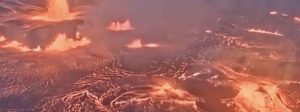Ash and hot gravel rained down on Friday on the Caribbean island of Saint Vincent, after powerful eruptions from a volcano that had been dormant for decades sent thousands of panicked locals fleeing to safety.
The initial blast from La Soufriere, the highest peak in Saint Vincent and the Grenadines, sent plumes of hot ash and smoke 6,000 meters (20,000 feet) into the air on Friday morning, the local emergency management agency said.
Also Read: St Vincent on red alert over volcanic eruption concerns, evacuations underway
A second, smaller eruption took place Friday afternoon, belching out a 4,000-meter-high ash cloud, the University of the West Indies Seismic Research Centre said.
“Evacuation of people in the red and orange zones to safe areas continues in earnest. Heavy ash fall has halted the process somewhat since visibility is extremely poor,” the National Emergency Management Ogranization said.
The 4,049-foot La Soufriere — French for “sulphur mine” — had not erupted since 1979 and its largest blow-up happened over a century ago, killing more than 1,000 people in 1902.
It had been rumbling for months before it finally blew.
It is now likely to keep erupting for days or weeks, scientists at the University of the West Indies, in Trinidad and Tobago, tweeted.
“Once there is one explosive eruption it is likely others can occur,” the university’s seismological research center said.
The emergency managemet agency warned that rainfall could harden the ash fall and pose a danger to human life.
Prime Minister Ralph Gonsalves started issuing evacuation orders late Thursday for residents in so-called red zones, home to some 16,000 people on the biggest island in the archipelago.
“Persons living in the ‘Red Zones’ are strongly advised to pack a quantity of personal items, secure your homes and animals; and be ready to be evacuated immediately,” police said in a statement after the eruption.
Also Read: Why do volcanoes erupt?
Zen Punnett, who lives on the 18-mile long island, said people panicked Thursday night as the evacuation orders came out but things were calmer Friday.
“I can feel and hear rumbling here in the green safe zone. We can see a huge ball of smoke. Keeping calm as much as possible and praying,” Punnett said Friday.
As of early Friday afternoon, most of the people in the red zone had been moved to safety, the Caribbean Disaster Emergency Management Agency said.
Royal Caribbean International and Celebrity Cruises said they were sending two ships to assist the evacuation effort.
Gonsalves said two more ships from cruise liner company Carnival were also on their way.
Those evacuated would be taken to shelters elsewhere in the island chain or other Caribbean territories that have offered assistance, such as Barbados and Saint Lucia, according to local media.
Philmore Mullin, director of Antigua and Barbuda’s National Office of Disaster Services, told AFP the twin island nation was ready to receive evacuees from Saint Vincent.
“I know for sure they will be scared out of their wits. The question is, what will happen after they move? Volcanoes don’t tell you what they are thinking,” said Mullin.
“If it continues to erupt for a long time, it will be life-changing for them. And, depending on the type of eruption, they might not be able to get back home for years.”
The Royal Saint Vincent and the Grenadines Police Force (RSVGPF) said in a statement quoted by local media that all officers had been told to report for duty immediately.
Also Read: Where is St Vincent Island?
“All members of the (RSVGPF) and its auxiliary forces who are currently on vacation leave are hereby informed that all leave has been canceled with immediate effect,” the release said.
Sirens sounded out on one side of the island of as traffic became gridlocked on the other in the rush to escape, local news portal Searchlight reported.





